Let’s be honest. Web3 UX sucks.
As onchain ecosystems continue to scale with L2 solutions and rollups, landscape fragmentation creates challenges for both users and developers.
Users face significant challenges with complex, time-consuming crosschain transactions. Bridging assets between different blockchains often involves multiple steps, high fees, and cumbersome processes. This friction can lead to abandoned transactions and a frustrating user experience, which ultimately impacts user engagement, satisfaction, and retention. In web2, we already see a 70% cart abandonment rate across the board. Add the complexity of web3 interactions, and this rate is doomed to only increase. So, how do we prevent this from happening?
Building native crosschain interoperability features into dApps is a great way to improve UX, but deploying on multiple chains is extremely tedious and a nightmare to manage. Each chain has its own protocols, standards, and governance structures, requiring developers to integrate and oversee multiple systems simultaneously. This is not optimal.
Luckily, we have a massive precedent to learn from: web2 applications.
We’re not Starting from Scratch; We’re Starting from Experience
We don’t need to reinvent the wheel here. Web2 companies have mastered online UX, providing us with insights that we can implement in web3 applications.
To illustrate how solving UX issues has transformed web2 user interactions, let’s consider Amazon’s 1-click checkout. Introduced in 1999, 1-click checkout revolutionized e-commerce by simplifying the online purchasing process. According to Forbes and Business Insider, the 1-click checkout reduced friction in online transactions by eliminating repeat steps, leading to a 30% increase in conversion rates. By streamlining the buying experience, Amazon improved user satisfaction levels and significantly boosted sales.
In other words, Amazon built an application that their users love to use.

Amazon's 1-click checkout was a game-changing innovation for web2 user experience (UX).
Impact of 1-Click User Flows
The success of Amazon’s 1-click checkout highlights the importance of removing as much friction as possible from online user flows.
Further research shows that complex user flows with multiple steps lead to higher abandonment rates:
Baymard Institute reports a 70% cart abandonment rate, which is often attributed to convoluted checkout processes involving too many clicks. Optimizing the checkout process can lead to an average increase of 35.26% in convergence rates.
HubSpot highlights that even a 2-second delay in mobile load time can reduce conversion rates by 4.3%. This underscores the impact that speed has on user retention.
KISSmetrics and Nielsen Norman Group further emphasize that each additional click increases the likelihood of user drop-off, making streamlined, minimal-click designs essential for effective user experience.
So, with all this in mind, how do we replicate Amazon’s 1-click success in the web3 space?
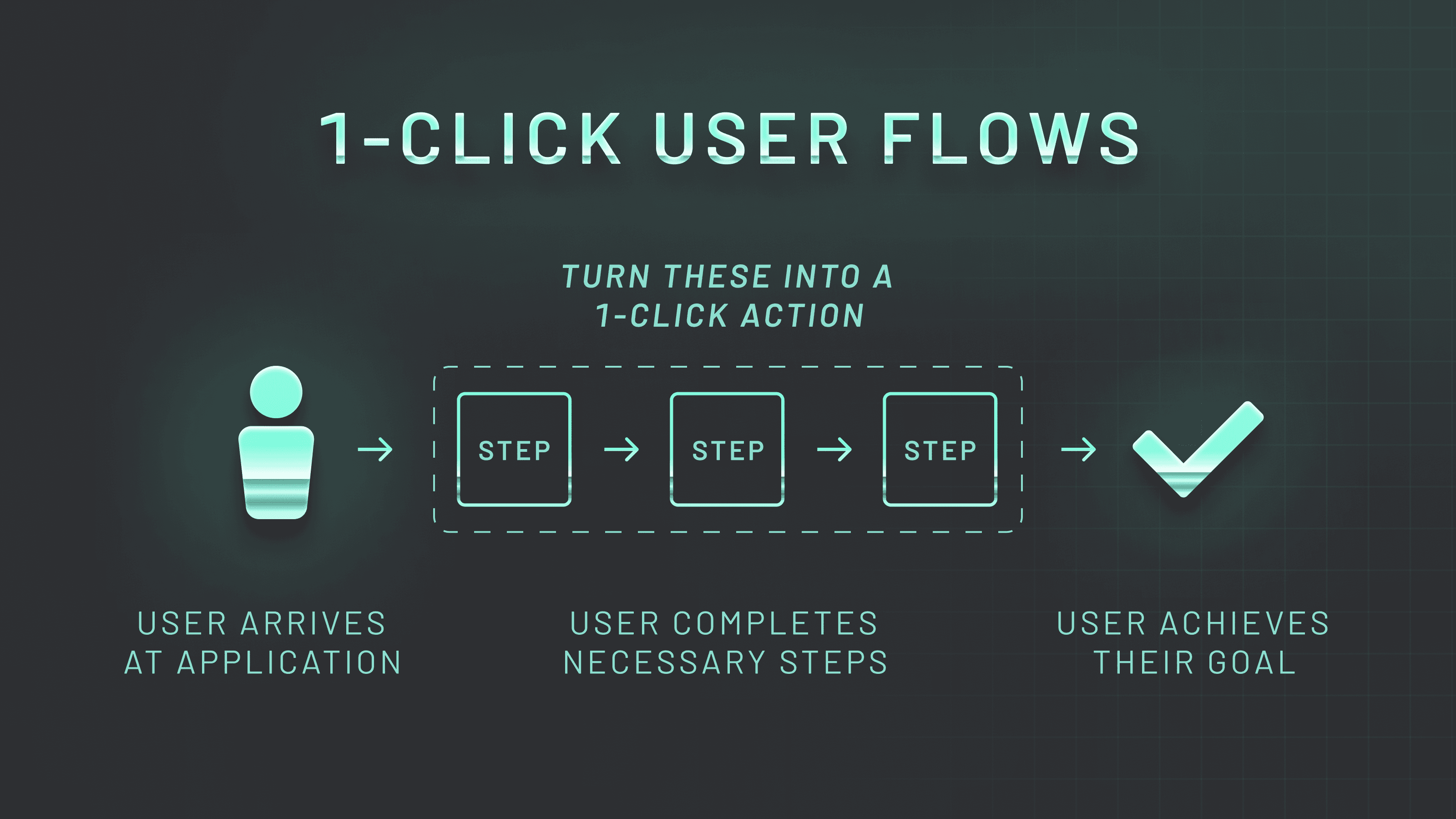
1-click user flows.
Bridging the Gap with 1-Click Intents
The goal here is simple: To build dApps that users love to use.
Traditional crosschain transactions involve several steps, including third-party bridges for asset transfers and confirmations. This tedious process is inefficient and can be confusing for users. To fix this issue on an ecosystem-wide scale, we need to attack this problem at the application level. We need a simple solution that empowers developers to integrate native, seamless crosschain interoperability into their dApps.
This is the challenge that Across aims to address.
Across enables developers to integrate 1-click crosschain UX straight into their dApps. This approach enables users to perform actions across 13 EVM blockchains with just one click, significantly reducing friction and improving engagement almost instantly.
But how exactly does it work? One word: Intents.
Across uses a robust Intents-based system that efficiently handles crosschain transactions in a fast, cheap, and secure manner. Intents enable our protocol to transform user desires into efficient onchain actions. Users specify their desired action (such as depositing funds crosschain into a dApp) in a single transaction request. Across then automatically handles the bridging assets and interacting with smart contracts “under the hood,” abstracting away the complexities from the user’s experience. This eliminates the need for manual bridging and makes crosschain interactions more efficient, accessible, and user-friendly.
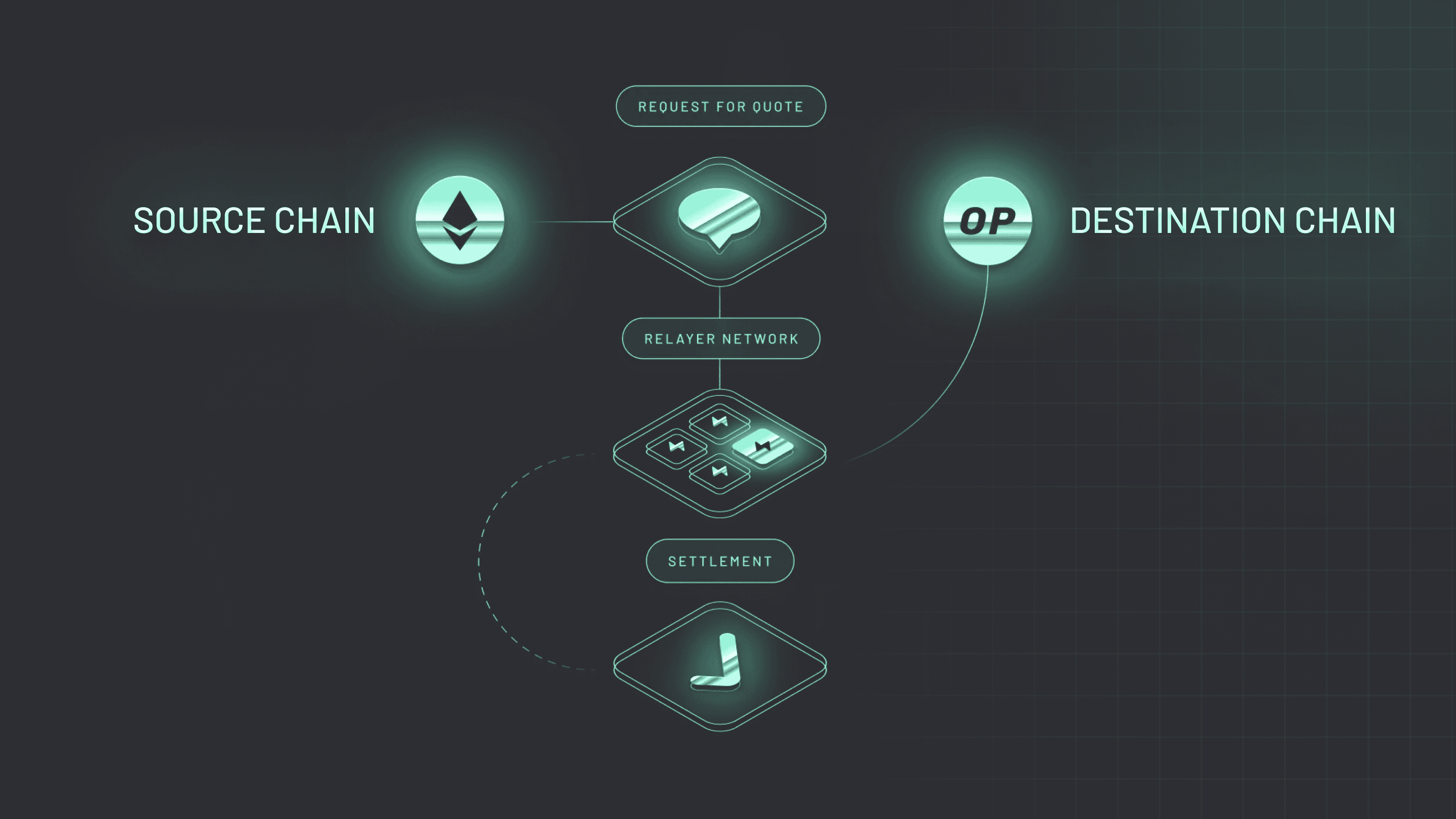
Across' intent-based system efficiently handles crosschain transactions in a fast, cheap, and secure manner.
The result is a seamless, 1-click experience where users can execute crosschain transactions without needing to bridge assets or confirm transactions on each chain manually.
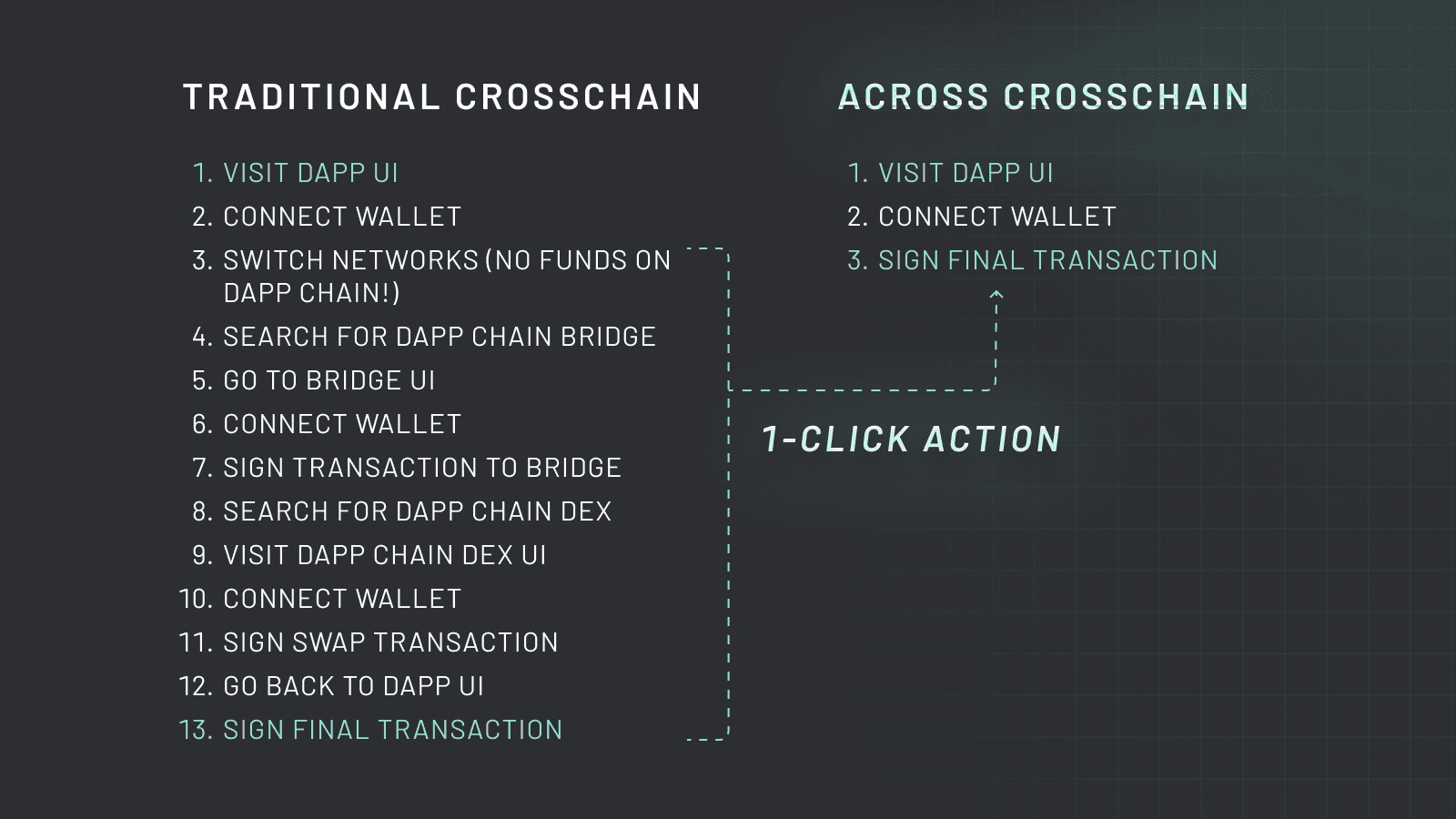
Across delivers a 1-click crosschain user experience.
Case Study: YieldNest Uses Across to Provide 1-Click Crosschain Liquid Staking & Restaking
Over nine dApps have integrated Across, and 24 more are currently in development. One example is YieldNest: a cutting-edge liquid restaking protocol built on EigenLayer.
YieldNest provides users with simplified, risk-adjusted exposure to curated Actively Validated Services (AVS) categories through its Native Liquid Restaking Tokens (nLRTs) and Liquid Restaking Tokens (LRTs).
By integrating Across, YieldNest can offer users a 1-click restaking experience. Users can deposit directly from various L2 networks without separate bridging steps. This integration leverages Across’s intent-based bridging technology, powered by ERC-7683, to facilitate efficient crosschain asset transfers in a single transaction. This enhancement has drastically simplified transactions and boosted user satisfaction.

YieldNest uses Across to provide 1-click crosschain liquid restaking.
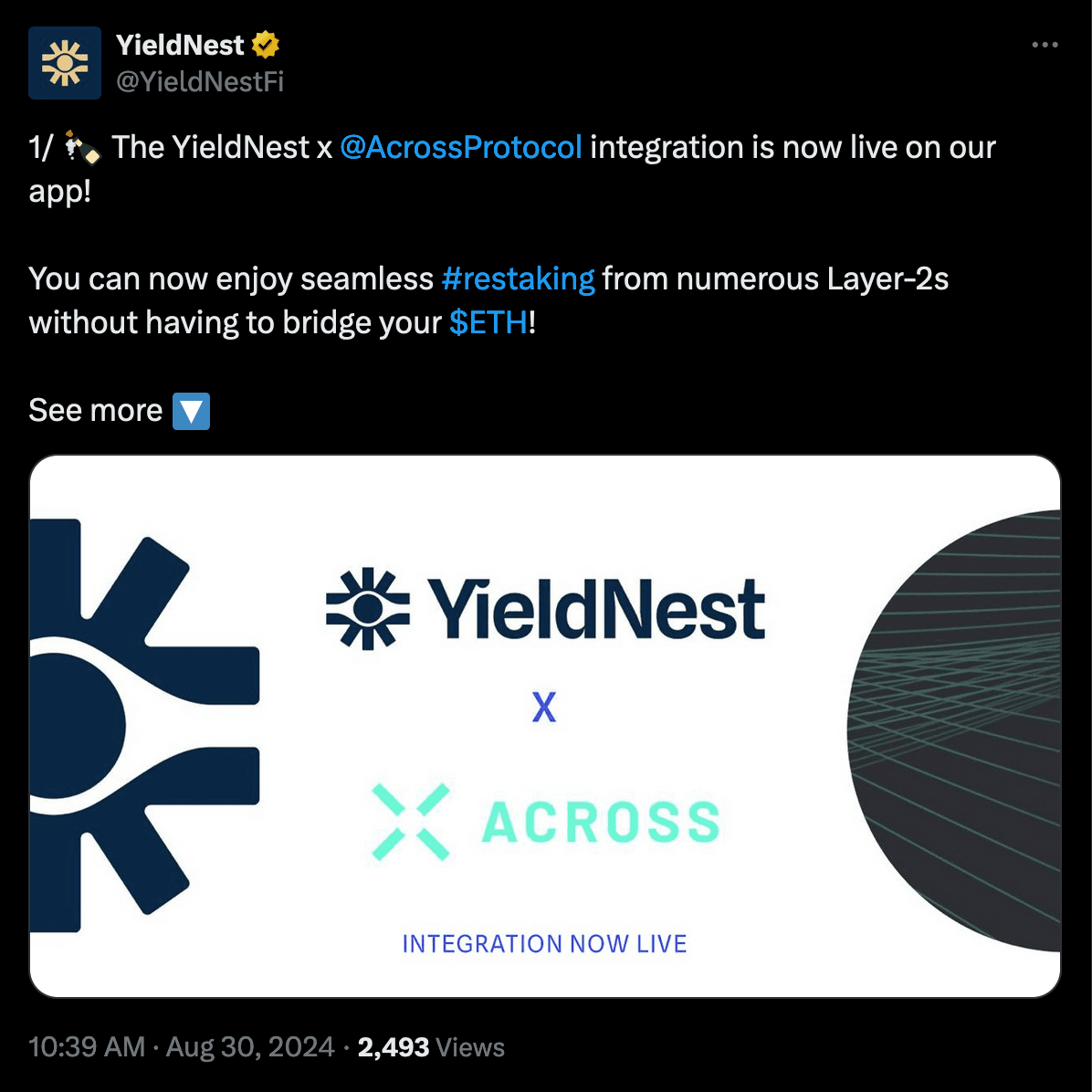
Across' integration with YieldNest is live.
Now It’s Your Turn
YieldNest is just one of many examples of how Across can bring native crosschain UX to dApps. Other protocols have used Across to provide their users with crosschain DeFi deposits, NFT purchases, in-game transactions, and much more.
The possibilities are endless.
At Across, we envision a future where seamless, 1-click crosschain transactions become the standard. This shift will facilitate the integration of crypto transactions into everyday experiences more naturally and efficiently.
We encourage dApp developers to embrace the interoperable future and use this opportunity to get ahead of the curve.
If you’re ready to level up with Across, contact our Head of Business Development on Telegram here or get started in our docs here.
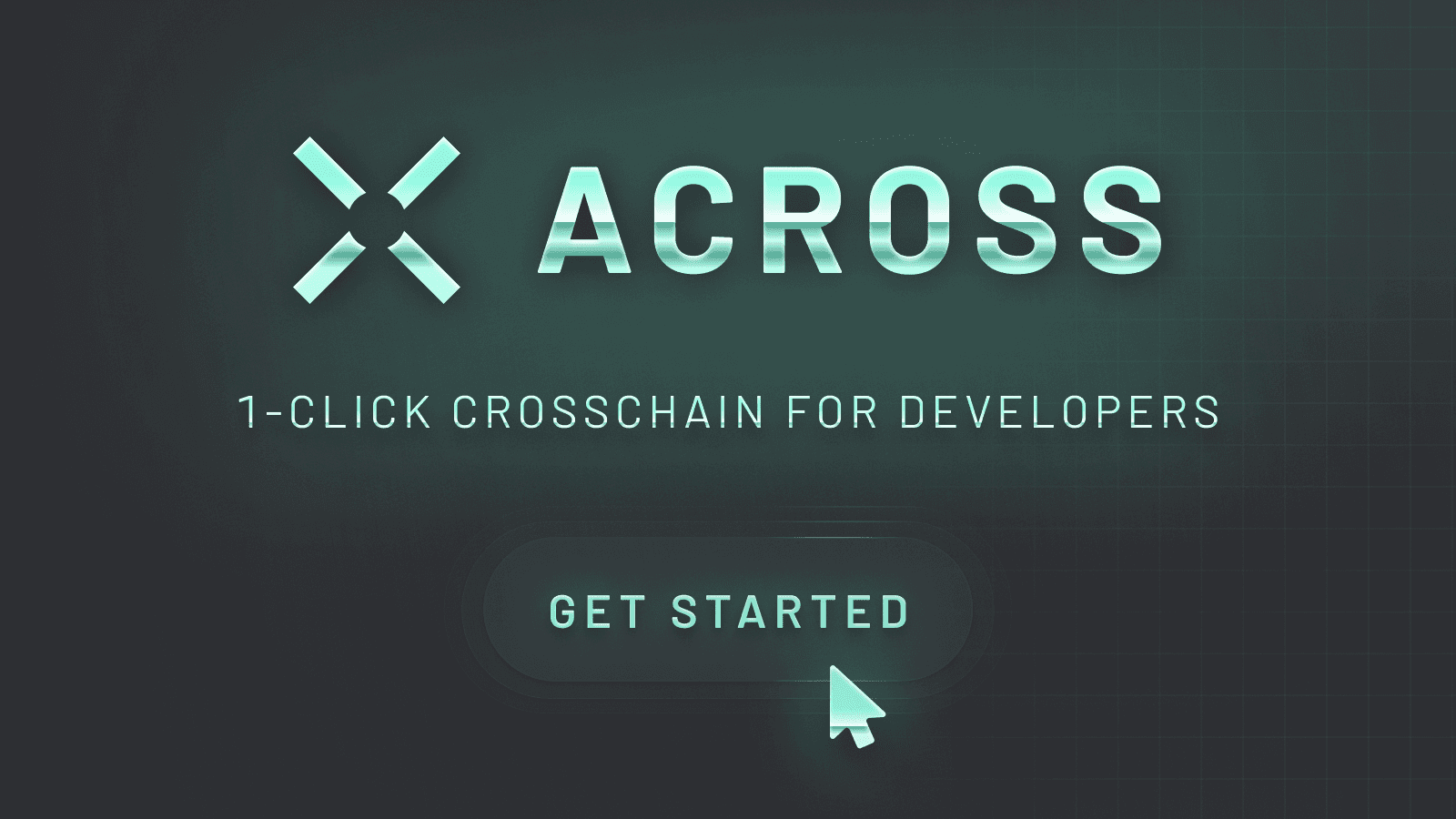
Anyone can easily build 1-click crosschain actions with Across. Get started today!
To learn more about Across’ solutions, check out our official documentation here.
Follow Across on Twitter for the latest updates and breakthroughs ahead in the world of crosschain innovation.
Have questions or feedback? Hop in our Discord server and join the conversation.





